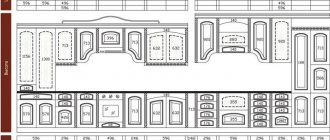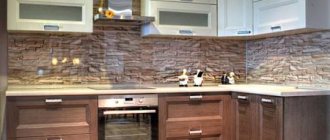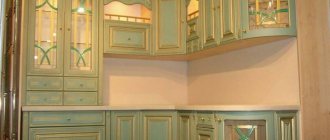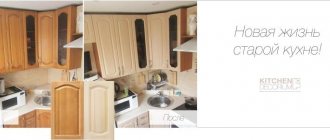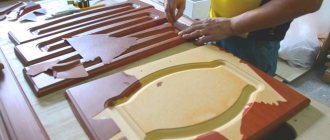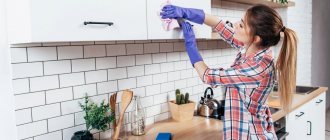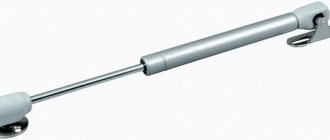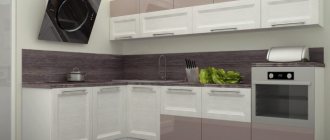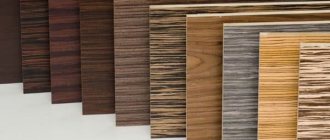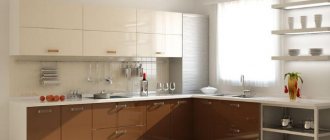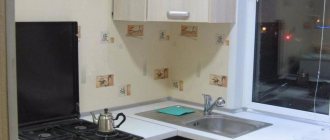<
>
Wooden kitchen furniture is a timeless classic. This choice will never go out of fashion and will highlight the good taste of the owner of the house. Unfortunately, the high cost of wooden sets and the huge number of counterfeits passed off as natural material stop buyers from purchasing such designs.
You can save your budget by choosing a furniture set with facades covered with a special material - veneer.
Features, advantages and disadvantages of veneer kitchens
Veneer is a layer of natural wood with a thickness of 0.5 to 10 mm. It is obtained by cutting a layer of solid wood on a special peeling machine. There are also more progressive methods - planing and sawing. As a rule, for the production of veneer, areas of wood with the most attractive pattern are selected.
The word "veneer" is of German origin. It is derived from “schpene”, which means “thin wood chips”.
The kitchen facade covered with veneer consists of three parts:
- base - the panel itself on which the coating is applied;
- veneer - a thin sheet of wood;
- edges - finishing of the sides of the facade (ends).
The advantages of veneer-coated front panels include:
- noble appearance. Unlike artificial materials disguised as wood (plastic, PVC film), veneer is natural, which means it is indistinguishable to look and feel from solid wooden facades;
- practicality. Veneered panels are resistant to adverse influences - high temperatures, mechanical damage, moisture and steam;
- possibility of restoration. Scratched coating can be sanded. If the damage is serious, veneer patches are used.
A veneer kitchen also has its disadvantages:
- although this solution is cheaper than using wooden facades, it is still less expensive than film, plastic or painting;
- if the technology for applying veneer coating is violated, it can easily deform and peel off;
- the wooden layer tends to darken over time - this process is called visual aging. Therefore, it requires a high quality protective coating.
Advantages of veneered products
- Noble look.
- Wide range of decorative possibilities.
- Affordable price.
- Reliability and durability.
- Maintainability.
Veneer is the thinnest cut of wood. Veneered kitchen facades in Vladimir retain the natural texture and smell of the forest, and therefore are externally indistinguishable from solid wood furniture structures. They provide many years of use, because classic wooden products always remain in fashion.
The production of facades from MDF involves finishing with natural eco-veneer. It is made from natural raw materials and is environmentally friendly. Through the use of modern technologies, it is possible to obtain a coating that imitates any species.
Buying a custom-made veneer set is an excellent opportunity to inexpensively create a unique, aesthetically attractive interior. Doors made from this material are much cheaper than similar wooden products, and a huge variety of textures and colors is a guarantee of a harmonious synthesis of new furniture and the overall design of the room.
It has good flexibility, so veneered products are not only straight, but also radius. This allows you to create headsets that successfully combine with any of the current styles - from modern to high-tech.
The veneer is attached to a moisture-resistant and high-strength MDF substrate, making it resistant to negative external influences. A matte or glossy paint coating is applied on top, protecting against minor accidental damage to integrity. And if scratches do appear, they can be easily sanded down and hidden using special means. For larger damages, a patch can be applied.
The production of veneered furniture should be entrusted to a reliable manufacturer. After all, if glued poorly, it can swell or peel off, as a result of which the entire product loses its presentable appearance.
Types of kitchen facades made of veneer
Depending on the design features, veneer kitchen facades can be of two types:
- solid - these are panels completely finished with veneer;
- paneled (framed) - consist of two parts: a base covered with a thin sheet of wood and a frame made of more expensive material (metal or wood).
Sometimes the frame can be made of MDF or chipboard - for contrast, but facades with expensive frames look more elegant.
Various materials are used as a base for veneer:
- inexpensive wood species;
- chipboard;
- MDF.
The main requirement for them is wood-likeness. Only in this case is the ideal adhesion of the veneer covering and the base guaranteed.
The manufacturer chooses what material to use. And, since the commercial side of the issue is important to him, chipboard is most often used - plates of wood chips glued with synthetic resins. However, veneered kitchen furniture made from chipboard can present the owner with an unpleasant surprise - it can become deformed or crack under the influence of moisture and high temperatures.
Soft and inexpensive types of wood - spruce, pine, thuja, linden and others - are also not the best option for kitchen furniture. They easily absorb moisture, are susceptible to temperature changes and are not durable.
Therefore, it is better to choose structures made from MDF - they are more expensive, but resistant to adverse conditions.
Photo: kitchens with veneered facades
Video: master class showing in detail the process of manufacturing a combined facade using veneer.
Production methods - how kitchen facades are covered with wood veneer
The quality of veneered facades largely depends on compliance with the technology of applying coating to the base. This is done in one of two ways:
- hot pressing (up to 120°C) - for flat panels;
- membrane-vacuum (up to 40°C) - for figured, curved facades.
First, the surface is well coated with adhesive. To attach the veneer to the base, a special viscous glue with filler is used - substances that are too liquid can seep through the pores of the veneer during the pressing process and ruin the appearance of the furniture.
Then the veneer is applied to the base and leveled well. Then placed under a press for 15-30 minutes. If the facade is overexposed, the product may swell.
After this, the panels are well dried, the edges are lined and the front side is coated with a special protective compound or enamel.
If the manufacturer used cheap PVA glue, then traces may remain on the facades, and their color may not correspond to the declared one - the acids included in the glue react with tannins contained in the wood and change its shade. Therefore, when purchasing, carefully inspect the product.
Color palette and types of decor for veneered kitchen facades
Any veneered kitchen façade will look sophisticated and elegant, but its aesthetic properties are largely determined by the type of wood from which the coating is made:
- oak - has a wide palette of shades: from white to black and a luxurious texture;
- alder - due to its velvety-looking structure and resistance to mechanical stress, it is often used in kitchens;
- rosewood - ideal for those who want furniture with an individual wood grain;
- cherry - the peculiarity of this tree is that its reddish tint only becomes deeper and more noble over time;
- ash - has a light “cool” shade, so it is very practical for kitchen facades;
- zebrano - an exotic striped option for luxurious interiors;
- walnut - has an elegant texture and a large selection of warm shades.
Depending on the type of varnish used, a veneer kitchen facade can be either matte or glossy. Matte surfaces look richer and more restrained, while shiny surfaces are ideal for small kitchens.
Veneer-coated panels themselves look quite harmonious, but to give the set even more sophistication, decor can also be used. For example, carved elements made of natural wood, floral and geometric patterns. And with the help of a special primer you can achieve the effect of aged panels.
Veneer also goes well with metal, glass and plastic decorative elements.
Classic in veneer
Classic kitchens can also be veneered. For them, materials with a calm pattern are used, which does not overshadow the traditional antique decor, but complements it with sophisticated accents, and vice versa - very bright, contrasting, the beauty of which is played up by all other details.
In the production of oak and rosewood veneer, the MEDEA factory uses the old secrets of cutting tree trunks, which have been perfected by the factory for more than 50 years; they make it possible to obtain sheets of exactly the same thickness.
FRANCESCO MOLON emphasizes the sophistication of rosewood and ebony knots, the veneer from which is also obtained in accordance with the ancient secrets of Italian craftsmen.
But the BAMAX brand demonstrates the unusual art of working with precious veneer from walnut roots. Its intricate design is unique and luxurious. In the “Amber” collection, the material is combined with solid cherry.
How to care for a veneer kitchen
Since veneer is, first of all, natural wood, this coating requires special care.
For daily cleaning, you can use a soft cotton cloth soaked in warm water and, if necessary, in a solution of a special furniture cleaner. Then the surfaces need to be wiped dry with a towel.
If you want to polish the facade, first clean it of dust with a cloth, then apply an alcohol-based degreaser (for example, for cleaning windows). After it has completely dried, you can apply polish and rub it in the direction of the wood fibers.
To ensure that the coating retains its appearance for a long time, avoid contact with hot liquids, direct pouring of water, and contact with sharp objects. Under no circumstances clean the veneer with abrasive products - they will scratch it.
Photos of kitchen units finished with veneer
<
>
A set with veneered fronts is not only not inferior to a set made of natural wood in appearance and performance properties, but is also a more practical and reasonable option for the kitchen.
Buy a good veneered kitchen
Do you want to purchase a high-quality, stylish and practical kitchen for a small investment? Specialists from the Massive factory will produce custom-made kitchen sets of any design, including shaped parts and other complex elements.
The Massive factory has been manufacturing MDF facades with high-quality veneer elements since 2004. We use absolutely safe, environmentally friendly raw materials and strictly comply with technology requirements, which guarantees the reliability and durability of the headset.
You can place an order in any convenient way:
- through an online application on the website;
- by email;
- by phone or;
- in our office in Moscow or Vladimir.
